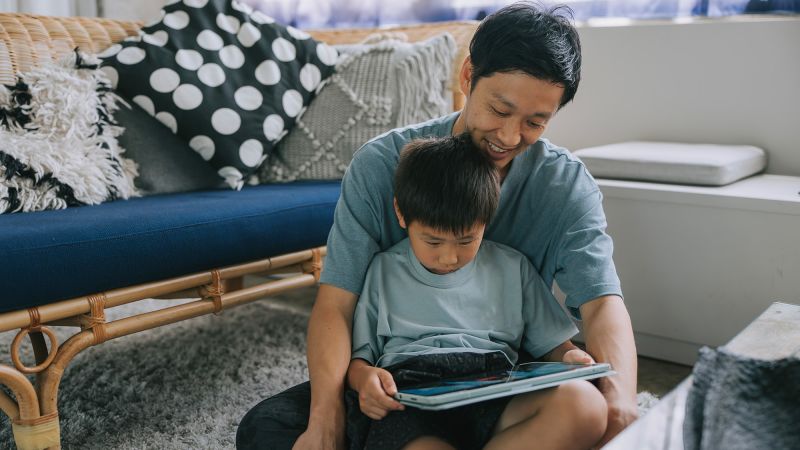Copyright Cable News Network

Kara Alaimo is a professor of communication at Fairleigh Dickinson University. Her book “Over the Influence: Why Social Media Is Toxic for Women and Girls — And How We Can Take It Back” was published in 2024 by Alcove Press. Parents tell me all the time that they’ve screwed up their kids because they allowed them to use smartphones and social media too young. Not true, says Dr. Kaitlyn Regehr, associate professor and program director of digital humanities at University College London and author of “Smartphone Nation: Building Digital Boundaries When Offline Isn’t an Option.” Her new book, published Tuesday, is full of tips on how to manage our kids’ screen time — and our own — in healthy ways. One big takeaway is about algorithms: We don’t have to let the formulas social networks use to decide what to show us determine what we consume online. I spoke to Regehr about how we can take control of our screen time and that of our kids and develop healthy habits. This conversation has been lightly edited and condensed for clarity. CNN: Your book starts with your 5-year-old daughter asking for a phone. How are you thinking about your young kids’ social media use? Dr. Kaitlyn Regehr: My goal is that the landscape around this will have drastically changed by the time my kids are teenagers. I want their generation to look back at ours as wildly unhealthy, in the same way we look back at the previous generation smoking in hospital delivery rooms. My goal is for the relationship we have with technology and the holds we have allowed it to have over us to begin to look odd and become socially unacceptable. I’m already seeding the idea of healthy digital engagement with my 3-year-old. CNN: How are you teaching your kids to use technology in healthy ways, and what advice do you have for other parents? Regehr: Most people are aware of the guidance to limit kids’ screen time to one to two hours per day. That was based on some good research on childhood obesity and diabetes. That guidance was to tell parents that if your kid is in front of a screen, they’re probably not moving around, and that’s bad for their physical health. And, of course, time off-screen is generally better than time on-screen. But that guidance was about physical health, not mental health. With very young children, we want to think about engaged types of viewing — so sitting together as a family, using that viewing as a launching pad for discussion. Sitting with your child and watching PBS, or a David Attenborough documentary, and having a discussion with them about it is qualitatively different than taking an iPad, putting a set of headphones on your kid, putting them alone in a room and putting on YouTube. We need to remind ourselves that every time we turn on our screen, whether it’s for our children or ourselves, we are making a choice. With that in mind, we can decide to make a different choice. I’m interested in encouraging quality consumption, not algorithmically fed spaces for kids. If we start having discussions early on about what we see on screens, we can open up the idea that these are not independent silos of consumption, but rather collective spaces. So, if you see something on a screen that makes you feel funny in your tummy, we can have conversations about that. I want my kids to move away from hyper-personalization and think of these devices more like household appliances. CNN: You also suggest using a “walkthrough method.” Can you explain what that is? Regehr: If you have a child who is on social media, I want to be clear: I don’t like this discourse that it’s too late because you’ve already screwed them up. Researchers tend to use something called a walkthrough method. That’s when you open up a frequently used application, scroll through a normal period of usage and talk about it. That will give you a very good idea of what your young person is consuming. Now, that may feel too personal, depending on the age of your teenager. We also need to keep in mind that these feeds are so hyper-personalized that sometimes they can be quite revealing with respect to sexuality, for example. If that feels too personal for the age and stage of your child, you can also do an exercise where you have weekly check-ins. You all bring in one piece of content that made you feel good, one that made you feel bad and one that made you question something. That will give you a sense of the kind of extremes that young person is consuming, and you can start to open up a discussion about it. A walkthrough method is something really good for us all to do with a partner. If you open up your feed and your partner says, “Hey, you’re getting a lot of ads for plastic surgery. Is that the best thing for you?” or “Gosh, you are getting a lot of images of kitchens or holidays we can’t afford,” you might want to question that. CNN: You say we all need to practice better digital nutrition. What is that, and how can we do it? Regehr: Old diet guidance was one of restriction, which I think is comparable to old screen time guidance. Now, diet guidance has moved toward a quality model. That is, we want to be putting nutrient-rich foods into our body. Similarly, when we think about our digital consumption, we should be thinking about what content is serving us, what is informing us, what is making us feel good and happy, and what is giving us a balanced view of the world. My hope in using a food-style pyramid is that we can start to think about what we want our digital diet to look like. We do not have to sit and be fed a conveyor belt of algorithmically offered content. You would never eat that way. In fact, you would never, for anything else in your life, allow something else to make that many choices for you about things like what you wore or where you went. But we’re putting algorithmically determined content into our bodies, and that is shaping what we believe and, I would argue, who we are. I want to encourage people to think about ways they can be much more empowered and active over these processes. CNN: How do we resist letting algorithms determine what we see? Regehr: We have to decide what we want more of, and what we want less of. And then you start to game your algorithm accordingly. So, you quickly move past the things you don’t want. Do not linger on it, do not comment on it, do not give it your attention. And you actively search for the things you do. Active searching used to be the cornerstone of the internet. We used Google and we searched for things. The thing about social media is we often don’t actively search, we passively consume. I do know some people who will go into their kid’s TikTok at night and actively search for science videos to train the algorithm. I would suggest that you might want to teach your kids how to do that for themselves — but the truth is, that works. I think people are becoming aware that devices are addictive and seeking to hold your attention at any cost. And I think if people start to frame it in that way, they become resistant to this idea, and they want to push back against it. I want to empower people to do that.



